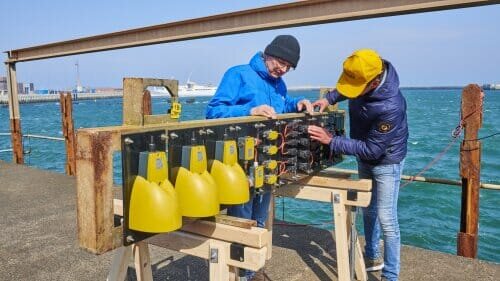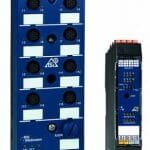Many of the switchgear series from the steute “Extreme” range are suitable for use in damp, wet or even saltwater environments. Corresponding corrosion tests, for example the saltspray test to DIN EN ISO 9227, control the quality of such devices and make them comparable to others regarding these features.
But how do the switching devices perform in practice? How are they really affected by intermittent waves or underwater fouling, for example? These are crucial questions for steute because the steute “Extreme” switches are often used in maritime applications – on ships, on oil rigs, in quayside anchoring systems, or at seaport container terminals.
In order to find answers to these questions, steute commissioned the Fraunhofer IFAM (Institute for Manufacturing Technology and Advanced Materials) in Bremen to conduct a 1-year exposure test at its site on the small German island of Helgoland. The test procedure was as follows: several samples from each selected “Extreme” switchgear series – including position switches, foot switches and pull wire switches – were fastened to the exposed South mole, where the North Sea waves splashed them for one year. Some of the devices were installed in the tidal range, meaning that they were sometimes submerged and sometimes not. Any potential limitations of the devices in moving saltwater would thus be revealed. Where would fouling be evident, and would it affect the functional capacity of the switches?
These are ambient conditions which switching devices are hardly ever exposed to in practice. Dipl.-Ing. Rainer Lumme, steute Product Manager “Extreme”: “The objective of these tests was to expose the switchgear to conditions so extreme that they went beyond all tests required by the approval bodies, allowing us to better understand any possible weak points.”
These threshold tests have now been completed. The final IFAM report is not yet available, but the appearance of the switching devices after one year of exposure to saltwater and spray, as well as some initial tests at steute of their functional capacity, have revealed the following: in all the different series, the devices are saltwater-resistant and still completely functional 12 months on. Even the labels and the laser-inscribed lettering are still legible. The pre-treated and powder-coated housings, for example of the foot switches, presented in a very good condition, and the “inner workings”, such as switching inserts, plungers and pedal axes, are also free of corrosion. This is testament to the high quality of both the surface coatings and the sealing.
steute will evaluate the IFAM test results in detail as soon as they are available, and will use them for further optimization of existing switchgear series, as well as the development of new “Extreme” devices. Rainer Lumme: “We now have the confirmation we needed that the plastics we use for our housings and actuators are unrestrictedly suited to Extreme requirements. We shall therefore intensify our efforts to replace metal with plastic – also in our more heavy-duty devices.”








